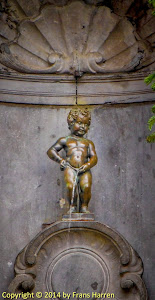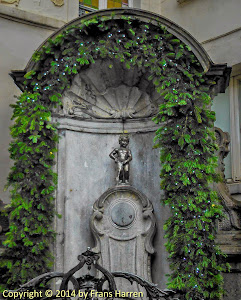Manneken Pis
Manneken Pis is a landmark small bronze sculpture in Brussels, depicting a naked little boy urinating into a fountain's basin. It was designed by Hiëronymus Duquesnoy the Elder and put in place in 1618 or 1619.
Location
The famous statue is located at the junction of Rue de l'Étuve/Stoofstraat and Rue du Chêne/Eikstraat. To find it, one takes the left lane next to the Brussels Town Hall from the famous Grand Place and walks a few hundred metres southwest via Rue Charles Buls/Karel Bulsstraat.
History and legends
The 61 cm tall bronze statue on the corner of Rue de l'Etuve and Rue des Grands Carmes was made in 1619 by Brussels sculptor Hieronimus Duquesnoy the Elder, father of the more famous François Duquesnoy. The figure has been repeatedly stolen: the current statue dates from 1965. The original restored version is kept at the Maison du Roi/Broodhuis on the Grand Place.
There are several legends behind this statue, but the most famous is the one about Duke Godfrey III of Leuven. In 1142, the troops of this two-year-old lord were battling against the troops of the Berthouts, the lords of Grimbergen, in Ransbeke (now Neder-Over-Heembeek). The troops put the infant lord in a basket and hung the basket in a tree to encourage them. From there, the boy urinated on the troops of the Berthouts, who eventually lost the battle.
Another legend states that in the 14th century, Brussels was under siege by a foreign power. The city had held its ground for some time, so the attackers conceived of a plan to place explosive charges at the city walls. A little boy named Julianske happened to be spying on them as they were preparing. He urinated on the burning fuse and thus saved the city. There was at the time (middle of the 15th century, perhaps as early as 1388) a similar statue made of stone. The statue was stolen several times.
Another story (told often to tourists) tells of a wealthy merchant who, during a visit to the city with his family, had his beloved young son go missing. The merchant hastily formed a search party that scoured all corners of the city until the boy was found happily urinating in a small garden. The merchant, as a gift of gratitude to the locals who helped out during the search, had the fountain built.
Another legend was that a small boy went missing from his mother when shopping in the centre of the city. The woman, panic-stricken by the loss of her child, called upon everyone she came across, including the mayor of the city. A city-wide search began and when at last the child was found, he was urinating on the corner of a small street. The story was passed down over time and the statue erected as a tribute to the well-known fable.
Another legend tells of the young boy who was awoken by a fire and was able to put out the fire with his urine, in the end this helped stop the king's castle from burning down.
Traditions
The statue is dressed in costume several times each week, according to a published schedule which is posted on the railings around the fountain. His wardrobe consists of several hundred different costumes, many of which may be viewed in a permanent exhibition inside the City Museum, located in the Grand Place, immediately opposite the Town Hall. The costumes are managed by the non-profit association The Friends of Manneken-Pis, who review hundreds of designs submitted each year, and select a small number to be produced and used.
Although the proliferation of costumes is of twentieth-century origin, the occasional use of costumes dates back almost to the date of casting, the oldest costume on display in the City Museum being of seventeenth-century origin. The changing of the costume on the figure is a colourful ceremony, often accompanied by brass band music. Many costumes represent the national dress of nations whose citizens come to Brussels as tourists; others are the uniforms of assorted trades, professions, associations, and branches of the civil and military services.
On occasion, the statue is hooked up to a keg of beer. Cups will be filled up with the beer flowing from the statue and given out to people passing by.
The statue has been stolen seven times, the last time being the 20th century by students from the village of Broxeele, a town with the same etymology as Brussels.
There is also a statue of Manneken Pis in Tokushima, Japan, which was a present from the Belgian embassy (Tokushima being twinned with Brussels).
Since 1987, the Manneken has had a female equivalent, Jeanneke Pis, located on the east side of the Impasse de la Fidélité/Getrouwheidsgang.
See: wikipedia













0 comments:
Post a Comment